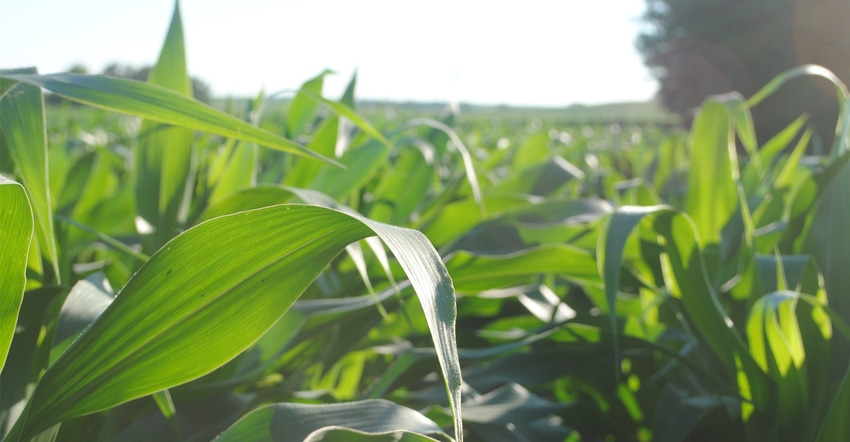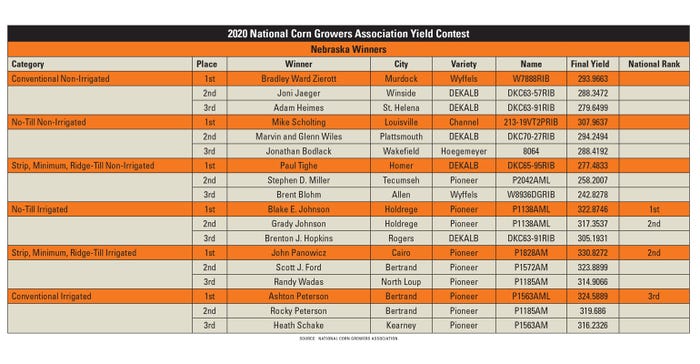
This past growing season was a big one for Blake Johnson and his son, Grady, of 37 Ag in Holdrege, Neb. They placed first and second, respectively, in the national no-till irrigated division of the National Corn Growers Association corn yield contest.
As if that wasn’t enough, the Johnsons also broke the world record for harvesting the most corn in an eight-hour period with their Claas Lexion 8600TT Class-8 combine.
“The conditions had to be just right,” Blake Johnson says of breaking the record. “The weather had to cooperate, and we were fortunate enough to have a half section of corn left to harvest.”
Astounding harvest rate
They began at 9:07 a.m. Nov. 5. During the time frame, they kept six trucks and three grain carts busy, hauling the grain to Loomis, Neb., to the CHS elevator. The totals were staggering at the end of eight hours.
Johnson had harvested 57,926.76 dry weight bushels off 217.92 acres. The harvest rate amounted to 7,240.84 bushels per hour, using 0.74 gallons of fuel per acre, with harvest loss of less than 0.7 bushels per acre. Johnson broke the previous record set earlier last fall by 500 bushels.
National champs
You would think a world harvest record might be enough laurels for one year, but taking the national championship and runner-up places in the National Corn Growers Association yield contest in the no-till irrigated category was icing on the cake.
“We have won the state contest before and placed 2nd or 3rd in the state, but this is the first time we have won nationally,” Johnson says. “About one-third of our farm is no-till and rotated between corn and soybeans, and the rest is strip till and corn-on-corn.”
Johnson’s farm is located on relatively flat terrain, with Holdrege silt loam soils. Years ago, the area was farmed conventionally, with gravity-flow irrigation. Today, much of the land is farmed with no-till practices and center-pivot irrigation, along with a small acreage that is watered through subsurface drip.
“We like the no-till practices,” Johnson says, “because they conserve moisture.” Johnson has no shortage of groundwater in his area, but he says, “We want to be good stewards and make sure the groundwater is there to last.”

The farm is grid-sampled for soil fertility on 2.5-acre grids every four years. They use variable-rate fertilizer application and incorporate livestock manure into their fertility program wherever it is feasible.
Throughout the growing season, Johnson spoon-feeds his corn crop. “We apply fertilizer when we do burndown in the spring,” he says. “We will apply 30 pounds of nitrogen with the planter, and then some variable-rate nitrogen with our dry spreader.” The rest of the nitrogen needs are applied through fertigation.
Pioneer P1138AML was the hybrid that took first and second place for the Johnsons in 2020. “This was a 111-day variety,” Blake Johnson says. “This past year, we started with 101-day maturity corn and finished planting with 115-day varieties.”
This upcoming season, Johnson will have an opportunity to sell more high-moisture corn to feedlots, so they will change their maturities, planting 106-day corn all the way up to 117-day maturity.
A third party manages their data, helping Johnson develop fertility prescriptions from the soil samples, looking at fertility zones and seeding prescriptions. They also study the data to get the right hybrid in the right fields.
Managing water and disease
This past year, Johnson’s fields were wet early on, and then things turned dry. While greensnap is often a concern with big wind events during crucial times in the growing season, his yield plot fields escaped any damage. He has some bacterial leaf streak in his fields, but it hasn’t been a big yield-killer yet.
Johnson controls disease pressure with two passes of fungicide treatments, keeping disease in check. “We control insect pressure with traits in the corn,” he says. “We control our water management by monitoring soil moisture with moisture probes, so we can schedule irrigation accordingly. We want to get the right amount of water at the right time.”
Early in the growing season, Johnson works to get enough water on the fields to promote plant growth, but not so much that it discourages root growth. Later in the season, they try to follow what the moisture probes tell them.
“We don’t want to hurt the crop or deprive it of moisture,” Johnson notes. “But at the end of the season, we want to leave the soil moisture profile empty and rely on Mother Nature to fill it back up.
“It’s all about producing the highest amount of corn for an inch of water, and the highest amount of corn for every pound of fertilizer,” Johnson adds.
For farmers, that is a strategy that means good stewardship and input efficiency.
See all the Nebraska winners in the table above. Learn more about the 2021 National Corn Growers Association Yield Contest at ncga.com.
About the Author(s)
You May Also Like






